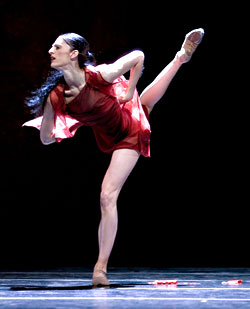Even more than last month’s program, “Valentine,” Pacific Northwest Ballet’s current bill is chock-full o’ love. Val Caniparoli’s The Bridge refracts the emotions that might lead lovers to choose death rather than separation through five couples who confront the same situation. The work seems more powerful now than in 1998, when it was made in tribute to the media-created “Romeo and Juliet of Sarajevo.” The slather of sentimentality has evaporated, and what remains shows Caniparoli’s choreography to be tightly focused, its narrow vocabulary of close, inward-turning coupling and mutually protective gestures leaving room for distinctive variations on the movement for each couple. There’s no effort to characterize each pair as “an aspect of love.” The movements are each an essay on emotion, not a mini-drama, and the work as a whole is the better for that. Like the Shostakovich string quartet it’s set to, the piece is relentlessly somber, but within the darkness skeins of deep color swirl.
Stylistically, The Bridge is ballet-plus; modern and folkloric elements are incorporated, but only as expressive extensions of traditional technique. In Dominique Dumais’ Time and Other Matter, ballet per se goes pretty much out the window. What’s fascinating is that the most unballetic passages in the piece—and they are definitely the most interesting—show that the PNB company can shrug off all the obvious hallmarks of classical training without losing the centered body and focused definition of gesture that make classical dancing possible. In the group sections of this work, elegant dancers like Noelani Pantastico and Christophe Maraval get just as down and funky as certified company punks like Rachel Foster and James Moore. Maybe you can have everything and ballet, too.
The piece itself is a mess, though a very promising one. It is badly organized, leading the audience to expect a work featuring a solo woman (Ariana Lallone on opening night) and then leaving her a passive observer for most of the piece. Annoying bits of postmod affectation—spoken voice-over, off-stage hoots and shouts—are irrelevant to what’s being danced, and I’m sorry, but fluffy red feather petals drifting down from the flies are so century before last. The choreographer runs out of ideas a good 10 minutes before she’s ready to throw in the towel. But severely rethought and edited, Time and Other Matter could be more than a showcase for some fine wriggly physiques. Lose the petals and bus poetry and we’ll still experience a conflicted woman teased by visions of the body electric but not quite ready to plug in herself.
The last work on the program, Balanchine’s La Valse, made quite an odd impression after the two preceding works. The dance begins as a conventional cotillion number offering charming variations on waltzing couples. But toward the end, Balanchine pulls a fast one. Suddenly the debutantes are visited by a figure in black right out of gothic romance who lures a woman in bridal white (Louise Nadeau) from her dreamy cavalier (Olivier Wevers) with a few tatty jewels and articles of mourning. She dies, while the cotillion dancers swirl around her. Oogah-boogah.
I never thought to say this, but maybe La Valse is too much of a gallimaufry to stand on its own as anything but a charming (for some) period curiosity. The senior prom setting is too lightweight to sustain the vampire-romantic finale. The corps passages are delicious to watch, but none of the individual dances is memorable on its own, and the spooky pantomime (even performed with dignity by Maraval, the evening’s most impressive dancer overall) is inert, predictable, and not emotionally convincing. Looking back over the first two dances of the evening, it was heartening to think how vastly more emotional terrain ballet has managed to explore and make its own in the last half-century. And how zestfully our dancers are striking out across that terrain to make their own discoveries.








